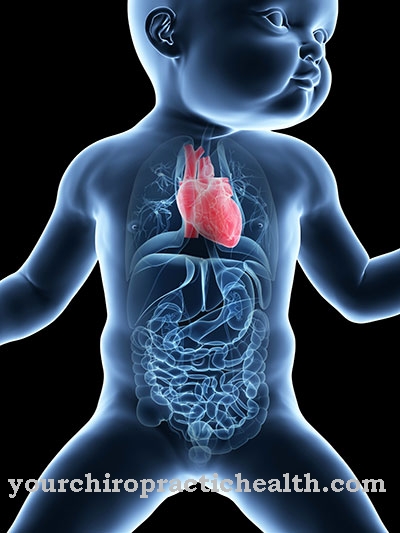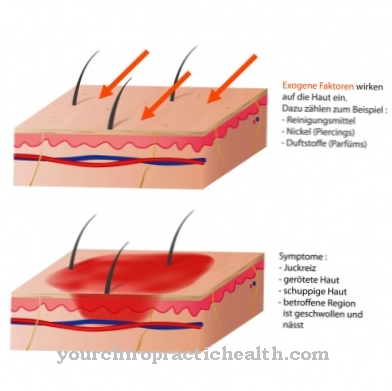The Muenke syndrome is characterized by craniosyostosis of the coronary suture, which is due to a mutation in the FGFR3 gene. The disorder is inherited as an autosomal dominant trait and is often accompanied by abnormal extremities. The treatment usually corresponds to a surgical procedure.
What is Muenke Syndrome?

© flashmovie - stock.adobe.com
In the case of craniosynostosis, one or more skull sutures ossify prematurely during embryonic development and thus prevent the physiological growth of the skull and brain. Many diseases from the group of congenital malformation syndromes with predominantly facial involvement contain such craniosyostoses. Such a disease is it Coronary Suture Synostosis Syndrome, also called Muenke syndrome is known.
The disease was first described in 1997. M. Muenke and colleagues are the first to describe it. The Muenke syndrome is characterized by a craniosynostosis of the coronary suture and also includes skeletal changes in the tarsus and carpal bones. The prevalence of the syndrome is currently unknown. The manifestation occurs in the early neonatal period or at the latest in early toddlerhood. Although the disease has not been conclusively researched, the cause has now been clarified.
causes
In many cases, the Muenke syndrome could be associated with familial accumulation. In these cases, the inheritance most closely resembles an autosomal dominant inheritance. However, cases have also been documented in which the syndrome appeared to have occurred sporadically. The cause seems to be a genetic mutation, which in the sporadic cases probably corresponds to a new mutation. The location of the mutation is also considered identified.
The disease is said to be based on mutations in the FGFR3 gene, which can be found at gene locus 4p16.3. Other syndromes have also been linked to the FGFR3 gene. One example of this is the so-called Apert syndrome. The gene codes within the DNA for the fibroblast growth factor receptor 3. Little is known about the physiological effects of the FGF-3 growth factor.
According to speculation, FGF-3 is a decisive factor especially for the embryonic period. The mutation of the receptors presumably means that the growth factor does not bind adequately during embryonic development.
Symptoms, ailments & signs
Muenke syndrome patients suffer from a variety of symptoms. Because of the premature closure of their coronary sutures, those affected have an abnormal head shape, which is also noticeable in facial anomalies. In addition to a shortened anterio-posterior skull diameter, the eye sockets are usually less deep.
Often these symptoms are associated with hypoplasia of the upper jaw. If the coronary suture is closed on one side, the eye sockets are flattened on the corresponding side. Usually the intelligence of the patient is not affected by the syndrome. Fusions of hand bones or tarsal bones are found on the limbs. Malsegregation is also conceivable on the carpal bones.
Cone epiphyses are also one of the possible symptoms. In some cases the clinical picture of the patient is also associated with osteochondromas. Phenotypic and thus symptomatic overlap with other syndromes such as Pfeiffer syndrome, Jackson-Weiss syndrome or Saethre-Chotzen syndrome are clinically conceivable manifestations.
Diagnosis & course of disease
The diagnosis of Muenke's syndrome is usually made in the neonatal period, as the disease can be recognized early by visual diagnosis. Around one patient in 15,000 newborns suffers from synostosis of the coronary suture. However, this phenomenon does not have to be automatically due to Muenke syndrome.
Diagnostics therefore require the detection of the pathogenic mutation in the FGFR3 gene. The patient's hands and feet may appear radiologically normal, so it is not sufficient to look for abnormalities in this regard for diagnosis. In principle, all children with a coronary synostosis can be screened for the specific P250R mutation.
This examination corresponds to a molecular genetic analysis. The exclusion of the mutation does not necessarily mean that the patient does not suffer from Muenke syndrome. In a few cases, the mutation could not be detected in those affected. However, the proof is considered to secure the diagnosis. The prognosis for female patients is less favorable.
Complications
Due to the Muenke syndrome, those affected suffer from various malformations and deformities that occur primarily on the head and face of the patient. These deformities often lead to psychological complaints and depression. Those affected often suffer from inferiority complexes and a reduced self-esteem.
The complaints often lead to feelings of shame and children in particular can be affected by bullying and teasing due to Muenke's syndrome. However, the intelligence is not impaired, so that the mental development of the patient proceeds without complications. There are also malformations of the limbs, so that there may be restrictions in various activities or movement restrictions in everyday life.
The quality of life is significantly reduced by the Muenke syndrome. There are no other complications in treating Muenke's syndrome. As a rule, no causal treatment is possible, but some surgical interventions must be carried out in order to avoid further consequential damage.
The life expectancy of the person concerned is usually not restricted. Treatment can also take place immediately after the birth. In some cases, the parents of the children are also affected by psychological complaints from Muenke's syndrome.
When should you go to the doctor?
The characteristic deformities in the head and face are clear indications of Muenke syndrome and usually lead to a diagnosis immediately after birth. In the case of mild symptoms, the responsible doctor should be informed of any symptoms. Occasionally, the carpal or tarsal bones have grown together, resulting in the gait typical of the disease. People who already have a family history of the disease should have a genetic test done at an early stage. The necessary treatment steps can then be initiated immediately after the birth.
Parents of affected children should also inform the family doctor about new symptoms and other deviating behavior of the child. In addition, a close inspection by a specialist is always necessary. Treatment usually takes place in the hospital or in a specialist clinic for genetic diseases. In addition to the general practitioner, the orthopedist or an internist can be called in. For chronic complaints, therapy and physiotherapy are also part of the treatment.
Therapy & Treatment
Causal treatment is not available for patients with Muenke syndrome. Gene therapy approaches offer hope for a causal therapy, but they have not yet reached the clinical phase. The treatment is purely symptomatic and thus depends on the symptoms in the individual case. Only surgical treatment options are possible to correct the skull anomalies.
The surgery is designed to help relieve the pressure on the brain caused by the early closure of the coronary suture. The cranial nerves are relieved in this way and are ideally less or not at all compressed after the procedure. A conservative treatment option is available for less severe craniosynostoses. For example, children who are more easily affected can be given skull shapes that they have to wear for a long time.
These skull shapes attempt to adequately model the skull. Since Muenke's syndrome is usually diagnosed in newborns, such a conservative remodeling is particularly useful: the shape of the head of babies is still adaptable. Conservative modeling ultimately has the same goal as operative modeling.
Physiological brain growth should be enabled by the treatment. In addition, the appearance of the head is adjusted to the average. Concomitant symptoms such as malformations of the extremities can be treated surgically. If they do not restrict or hinder the person affected, such treatment is not absolutely necessary.
Outlook & forecast
Muenke syndrome is a rare disease that can now be treated surgically. If the premature closure of the coronary suture is detected in good time, the prognosis is good. Any malformations can be treated surgically. Appropriate medication can be prescribed for symptoms such as pain or sensitivity disorders. Coronary suture synostosis syndrome does not reduce life expectancy.
The quality of life can be slightly restricted by the complaints mentioned as well as possible scars on the face and head. In general, however, the prognosis is positive. Children with Muenke syndrome are particularly prone to inner ear hearing loss. Poor hearing can lead to problems later in life, for example, when the patient is no longer able to understand instructions or to find their way in everyday life.
Due to exclusion and a reduced self-esteem, some of the sick develop psychological complaints. Well-being can be reduced if the sick do not have a good support network in the form of parents, relatives, friends and therapists. Children who suffer from Muenke syndrome definitely need support in everyday life in order to remain mentally and physically healthy despite the illness.
prevention
Muenke syndrome cannot be prevented because it is influenced by genetic factors rather than external ones. Genetic counseling during pregnancy is the only preventive measure.
Aftercare
In most cases, those affected with Muenke syndrome have very few and only very limited measures available for direct follow-up care. First and foremost, a quick and, above all, an early diagnosis of this disease should be made so that no further complications can occur. Since Muenke syndrome is a genetic disease, it cannot be completely cured.
However, if you want to have children, genetic testing and counseling can be useful to prevent the syndrome from recurring. Most of those affected are dependent on an operation. The patient should definitely rest and take it easy after such an operation, ideally bed rest should be kept. Exhausting or physical activities should also be avoided in order not to unnecessarily stress the body.
In many cases, those affected by the syndrome are also dependent on the help and support of their own family in everyday life. Loving and intensive conversations with family and friends also have a very positive effect on the further course of the disease. It is not uncommon for this to prevent the development of depression or other psychological disorders.
You can do that yourself
Muenke syndrome is usually treated surgically and with medication. The most important self-help measure is to take care of the body after the procedure and to consult closely with the responsible doctor. Parents of affected children should observe the child carefully and inform the responsible doctor in the event of any abnormalities.
In general, Muenke's syndrome can be treated relatively well and does not result in permanent impairment in the quality of life. However, deformities and malformations almost always remain, which can sometimes be a major emotional burden for those affected. For this reason, medical treatment should be supported by therapeutic measures.
Severely affected children with developmental discrepancies were advised earlier to attend a special kindergarten and later a special school. Instead, reference is made today to inclusion in mainstream schools. Children without any other abnormalities can go to normal and higher schools anyway.
Comprehensive therapy is necessary, especially in the case of severe mobility restrictions. Parents can support these measures by supporting the child in everyday life. Usually further physiotherapeutic measures are indicated.
Since the disease can also represent a considerable burden for relatives, parents and friends should also seek therapeutic help. The therapist can also establish contact with other affected persons and, if necessary, refer the parents to a self-help group.


.jpg)










.jpg)

.jpg)
.jpg)











.jpg)